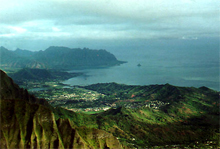Insular Pacific - Hawaiian LME
Introduction
The Insular Pacific-Hawaiian Large Marine Ecosystem is characterized by its tropical climate. This LME includes the main Hawai'ian Islands of Hawai'i, Maui, Lanai, Molokai, Oahu, Kauai, and Niihau, as well as the outer northwest islands and their near-shore boundaries. The region is influenced by equatorial currents and prevailing northeasterly trade winds. The Hawai'ian Islands were formed by successive periods of volcanic activity, and are surrounded by coral reefs. Ocean surface temperatures range from 21 to 29 degrees Celsius. For more information on environmental conditions influencing the Hawai'ian Islands (climate, temperature, salinity, waves, currents and tides), see the Ocean Atlas of Hawai'i.
Productivity, Fish and Fisheries
The Insular Pacific-Hawaiian LME is a low productivity ecosystem with a high diversity of marine species. There is a high percentage of endemic species: about 18%-25% of the shore fishes, mollusks, polychaete worms, seastars, and algae exist only in this LME, making the region vulnerable to invasive marine species. The important algal habitats and coral reef ecosystems are used by a variety of organisms for food, shelter, and nursery grounds. For more detailed information on coral reefs and fisheries, go to the University of British Columbia Fisheries Center. It is an important habitat for the North Pacific humpback whale. Most fisheries (bottomfishes, nearshore reef fishes, and invertebrates) are concentrated in the coastal waters of the narrow shelf areas surrounding the islands but there is a highly migratory pelagic fishery as well. Tuna (bigeye, yellowfin, skipjack, albacore) is the most valuable resource. Transboundary fisheries resources have importance and value to the Pacific rim nations, and to the fleets of the USA, fishing within and beyond its Exclusive Economic Zone. Spiny and slipper lobsters are both harvested, with spiny lobster as the primary target. Fisheries management plans are designed to eliminate interactions with the endangered Hawaiian monk seal, sea turtles and sea birds.
Pollution and Ecosystem Health
This LME does not have a comprehensive coastal monitoring program and the sampling effort in estuaries is focused on known areas of concern. The primary causes of estuarine impairment are increased concentrations of suspended solids and nutrients. Kaneohe Bay is the focus of a long term project to monitor water quality and sediment processes. There has been some destruction of mangroves. Coral reef ecosystems are biologically critical to this LME, but are being impacted by areas of intensified human activity. This is resulting in sedimentation, eutrophication, and pollution. A question needing further study is the effect on fish habitat of the harvesting of precious corals. Some habitat-destructive fishing techniques are coral tangle-netting and dredging.
Socio-economic and Governance
Hawaiians have traditionally used the LME for fishing, aquaculture, trade, transportation, and communication. Coral reef ecosystems and fisheries have major cultural and economic importance. Fisheries are partially artisanal and geared towards subsistence and partially focused towards large pelagic species for profit. The diversity of water supplies of different temperatures allows the culture of almost all aquaculture species all year: tropical fish, trout, salmon, carp, milkfish, mullet, mahimahi, shrimp, shellfish and seaweed. Some mangroves have been destroyed to make way for aquaculture. The rate of species extinction has accelerated with the arrival of the Polynesians followed by the arrival of the Europeans in the late 1700s. See Bishop Museum for information on endangered species. This LME is governed by the USA and by the State of Hawai'i (USA). The Western Pacific Fishery Management Council manages its fisheries. Pacific whales are protected under the International Whaling Commission (IWC), which prohibits non-subsistence hunting by member nations. A Hawaiian Islands Humpback Whale National Marine Sanctuary was designated in 1992 to protect humpback whales and their habitat within the sanctuary, and to educate the public on the relationship of humpback whales with the Hawaiian Islands marine environment. It manages human uses within the sanctuary.



